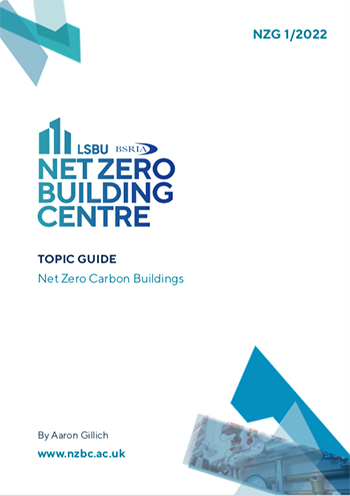The LSBU and BSRIA Net zero building centre, topic guide Net Zero Carbon Buildings
The LSBU and BSRIA Net zero building centre, topic guide Net Zero Carbon Buildings
This guide, designed for facilities managers, building owners, building occupiers, building services professionals and product manufacturers, is a succinct document with some specific details on the theme. Starting with what net zero is, where it stemmed from, the related legislation, (in particular the UK’s net zero strategy) and the significant role the built environment plays in the mix, as well the impact of 'business as usual'.
The document goes on to explain embodied carbon and operational carbon, along with simple comparative charts for office, residential and school buildings from regulation standards to ultra low-energy building levels. It goes further to describe how these balance and look when spread across a buildings' life-span, explaining the concept and necessity of considering whole life carbon.
The document touches on details about designing and building to net zero, describing the hierarchy of approach to impact measures, from the greatest impact potential of the fabric (the so called fabric first approach), to onsite renewables and carbon off-sets. It highlights the stark realities in the performance of the current building stock, where average existing homes might have space heating demands of approximately 130 kWh/m2.year, wheras typical new build homes consume 85 kWh/m2.per year, and lower standards that display fabric first principles such as Passivhaus or LETI, consume just 15 kWh/m2.year. The report does not forget to mention the added benefits of action that run beyond carbon such as reducing system sizing and cost, comfort improvement as well as health benefits, along with operating costs, diminishing fuel poverty and reducing demand for new energy infrastructure.
The report highlights operations through tools such as, BREEAM, LEED, the Well Building Standard as well as NABERS and how frameworks such as BSRIA’s Soft Landings can assist in the flow of information needed by stakeholders to maintain performance over longer time periods. This moves the document neatly onto systems used in net zero buildings, and the role of solutions such a heat pumps, heat networks, and direct electric heating, along with hybrid combination systems or biofuels as part of net zero infrastructure systems. Finally describing the future of the energy mix, including gas and hydrogen, with useful infographics on production, market, transmission, distribution, and consumer issues, showing how mixes are likely to change between now and 2050.
Finally in summing up, the document describes the drivers for change and legislation. It praises the current goals that have been set but highlights the lack of actionable policies, despite 75% of local authorities now declaring climate emergencies. The document very clearly and definitively aligns this with carbon budgets and the relative ease with which historical carbon budgets were met through the phasing out of coal, noting that savings in future budgets as we now enter the 6th budget, will become increasing difficult.
Article written by editor based on a review of the BSRIA publication "Net Zero Carbon Buildings (NZG 1/2022)" written by Aaron Gillich and available for free download via the weblink above.
[edit] Related articles on Designing Buildings
- Actuate UK issues climate warning and urges action.
- A zero-carbon UK by 2050?
- Carbon negative.
- Carbon neutral.
- Climate Change Act.
- CO2nstruct Zero programme grows to over 70 businesses.
- Fabric first investigation into net zero for existing buildings.
- Nearly zero-energy building.
- Net Zero All Party Parliamentary Group NZ APPG.
- Net zero by 2050.
- Net zero (whole life) carbon.
- Smoothing the path to net zero.
- Transform to Net Zero.
Featured articles and news
Deputy editor of AT, Tim Fraser, discusses the newly formed society with its current chair, Chris Halligan MCIAT.
Barratt Lo-E passivhaus standard homes planned enmasse
With an initial 728 Lo-E homes across two sites and many more planned for the future.
Government urged to uphold Warm Homes commitment
ECA and industry bodies write to Government concerning its 13.2 billion Warm Homes manifesto commitment.
Places of Worship in Britain and Ireland, 1929-1990. Book review.
The emancipation of women in art.
CIOB Construction Manager of the Year 2025
Just one of the winners at the CIOB Awards 2025.
Call for independent National Grenfell oversight mechanism
MHCLG share findings of Building Safety Inquiry in letter to Secretary of State and Minister for Building Safety.
The Architectural Technology Awards
AT Awards now open for this the sixth decade of CIAT.
50th Golden anniversary ECA Edmundson awards
Deadline for submissions Friday 30 May 2025.
The benefits of precast, off-site foundation systems
Top ten benefits of this notable innovation.
Encouraging individuals to take action saving water at home, work, and in their communities.
Takes a community to support mental health and wellbeing
The why of becoming a Mental Health Instructor explained.
Mental health awareness week 13-18 May
The theme is communities, they can provide a sense of belonging, safety, support in hard times, and a sense purpose.
Mental health support on the rise but workers still struggling
CIOB Understanding Mental Health in the Built Environment 2025 shows.
Design and construction material libraries
Material, sample, product or detail libraries a key component of any architectural design practice.
Construction Products Reform Green Paper and Consultation
Still time to respond as consultation closes on 21 May 2025.
Resilient façade systems for smog reduction in Shanghai
A technical approach using computer simulation and analysis of solar radiation, wind patterns, and ventilation.

























Comments
[edit] To make a comment about this article, click 'Add a comment' above. Separate your comments from any existing comments by inserting a horizontal line.